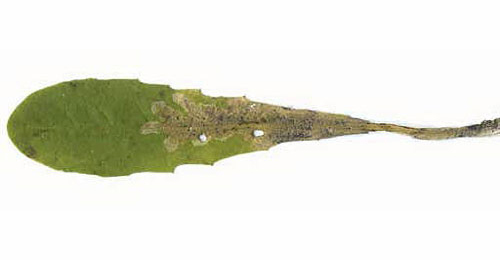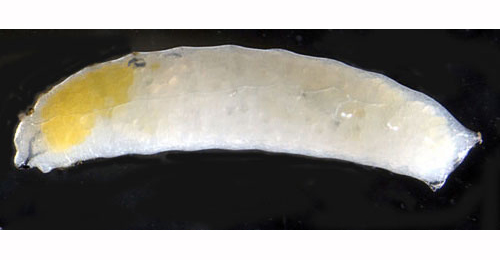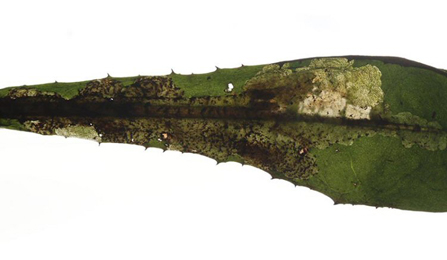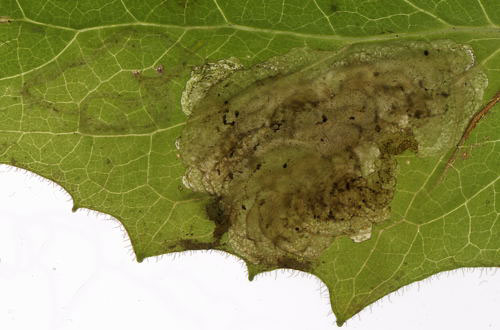|
||||||
|
PRENANTHES. Purple Lettuce. [Asteraceae] |
|
Only one species of Prenanthes is recorded in Britain, the introduced Purple Lettuce (P. purpurea L.). Six British miners are recorded on Prenanthes. A key to the European miners recorded on Prenanthes is provided in Bladmineerders van Europa. |
Key for the identification of the known mines of British |
1a > Stem mine: An external stem mine; frass in two rows of disconnected strips. Pupation in stem at end of mine. Puparium black |
|
Ophiomyia heringi Stary [Diptera: Agromyzidae]. |
1b > Leaf-miner: A distinctive mine primarily above mid-rib, with irregular short lateral offshoots into leaf blade. Pupation external (Spencer, 1972: 51 (fig. 172), 55; Spencer, 1976: 270, 271 (fig. 486)). Branched, whitish, upper-surface corridor; main axis overlying the midrib; side branches overlying the main lateral veins. (In Campanula and Phyteuma the mine is much less branched, sometimes nothing more than a corridor on top of the midrib). Frass in rather long strings. Usually the mines begins as a long and narrow, shallow, tortuous lower-surface corridor that ends upon the midrib but otherwise is not associated with the leaf venation. Often this initial corridor is filled with callus, and then even less conspicuous. Pupation outside the mine. A linear mine on the upper surface, usually following the midrib and showing side branches along the veins. The frass is in strings. |
|
Liriomyza strigata (Meigen, 1830) [Diptera: Agromyzidae]. |
1c > Leaf-miner: A whitish blotch-mine along mid-rib, with offshoots into leaf blade. Pupation takes place at the base of the mid-rib. Puparium yellowish white |
 Mine of Ophiomyia cunctata on Taraxacum officinale Image: © Willem Ellis (Bladmineerders van Europa) |
|
Ophiomyia cunctata (Hendel, 1920) [Diptera: Agromyzidae]. |
1d > Leaf-miner: Larva mining both lower and upper surface, unusually long, linear, conspicuously broad, frequently largely on the underside of the leaf. Pupation external (Spencer, 1972b: 76 (fig. 251); Spencer, 1976: 445 (fig. 780), 446). Corridor mine. The first part consists of a very long and narrow lower-surface corridor; the mine is quite shollow here, and often inconspicuous. The second part is upper-surface, uusally much shorter, and widens abruptly. Pupation outside the mine. |
|
Phytomyza marginella Fallén, 1923 [Diptera: Agromyzidae]. |
1e > Leaf-miner: A small primary blotch, often several larvae feeding together (Spencer, 1972b: 56 (fig. 186); Spencer, 1976: 270, 271 (fig. 483)). Brown, upper-surfsce blotch; often several larvae in a mine. The blotch is preceded by a short initial corridor, often overrun by the later blotch. Frass in a few, small grains. Secondary feeding lines well visible. Pupation outside the mine, exit slit in upper epidermis. Small upper surface blotch, with occasional galleries leading from the blotch. Often several larvae feeding together. |
 Liriomyza sonchi larva, lateral Image: © Willem Ellis (Bladmineerders van Europa) |
|
Liriomyza sonchi Hendel, 1931 [Diptera: Agromyzidae]. |
1f > Leaf-miner: The mine begins with a very narrow full depth corridor, that ends upon the midrib. Subsequently a broad corridor, or rather an elongated blotch, is made overlying the midrib; from here broad, lobe-like extensions are made into the blade. Frass in discrete grains. Secondary feeding lines conspicuous. The larva is capable of leaving the mine and restarting in a new leaf, in which case the association with the midrib may be lost. Pupation after vacation of the mine. |
 Mine of Trypeta immaculata on Taraxacum Image: Rob Edmunds (British leafminers) |
|
Trypeta immaculata (Macquart, 1835) [Diptera: Tephritidae]. |
1g > Leaf-miner: Elongated upper-surface blotch, preceded by a corridor (exceptionally, visible in the picture, as a long lower-surface corridor). Primary and secondary feeding lines conspicuous. Older mines quickly turn brown. Pupation outside the mine. The mine starts as a corridor which quickly broadens into a blotch, which appears dark with white borders. It is intitially circular or slightly elongated but becomes irregular as the mine matures. The larva is shown and feeding lines are also visible. The mine quickly turns brown and pupation is ouside the mine. The adult was bred and emerged on 10.vii.2017. First discovered in the UK in 2010 (Godfray, 2011). |
|
|
| Liriomyza puella (Meigen, 1830) [Diptera: Agromyzidae] |
| Last updated 06-Jul-2019 Brian Pitkin | ||

